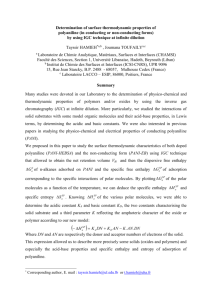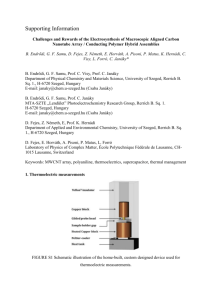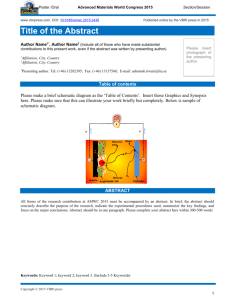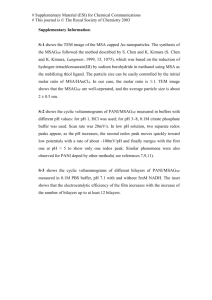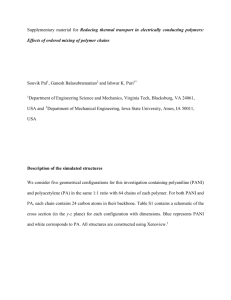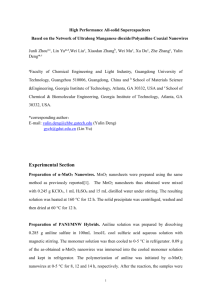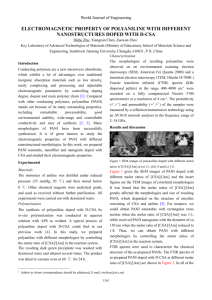2825-RR - Bulgarian Chemical Communications
advertisement
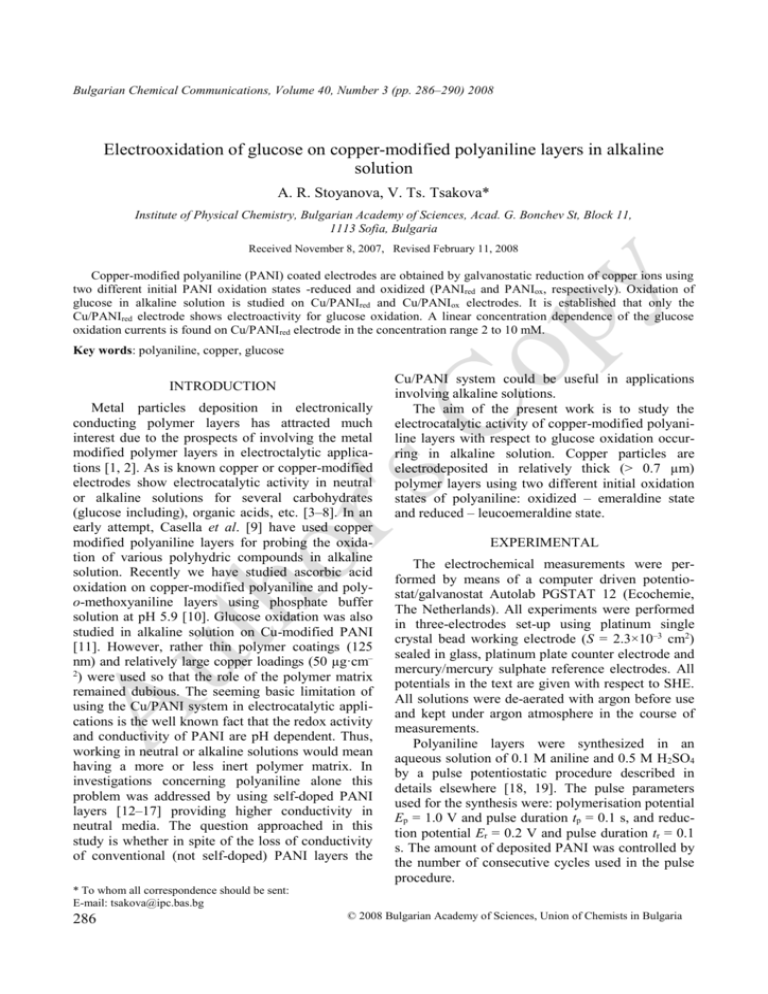
Bulgarian Chemical Communications, Volume 40, Number 3 (pp. 286–290) 2008 Electrooxidation of glucose on copper-modified polyaniline layers in alkaline solution A. R. Stoyanova, V. Ts. Tsakova* Institute of Physical Chemistry, Bulgarian Academy of Sciences, Acad. G. Bonchev St, Block 11, 1113 Sofia, Bulgaria Received November 8, 2007, Revised February 11, 2008 Copper-modified polyaniline (PANI) coated electrodes are obtained by galvanostatic reduction of copper ions using two different initial PANI oxidation states -reduced and oxidized (PANIred and PANIox, respectively). Oxidation of glucose in alkaline solution is studied on Cu/PANIred and Cu/PANIox electrodes. It is established that only the Cu/PANIred electrode shows electroactivity for glucose oxidation. A linear concentration dependence of the glucose oxidation currents is found on Cu/PANIred electrode in the concentration range 2 to 10 mM. Key words: polyaniline, copper, glucose INTRODUCTION Metal particles deposition in electronically conducting polymer layers has attracted much interest due to the prospects of involving the metal modified polymer layers in electroctalytic applications [1, 2]. As is known copper or copper-modified electrodes show electrocatalytic activity in neutral or alkaline solutions for several carbohydrates (glucose including), organic acids, etc. [3–8]. In an early attempt, Casella et al. [9] have used copper modified polyaniline layers for probing the oxidation of various polyhydric compounds in alkaline solution. Recently we have studied ascorbic acid oxidation on copper-modified polyaniline and polyo-methoxyaniline layers using phosphate buffer solution at pH 5.9 [10]. Glucose oxidation was also studied in alkaline solution on Cu-modified PANI [11]. However, rather thin polymer coatings (125 nm) and relatively large copper loadings (50 µg·cm– 2 ) were used so that the role of the polymer matrix remained dubious. The seeming basic limitation of using the Cu/PANI system in electrocatalytic applications is the well known fact that the redox activity and conductivity of PANI are pH dependent. Thus, working in neutral or alkaline solutions would mean having a more or less inert polymer matrix. In investigations concerning polyaniline alone this problem was addressed by using self-doped PANI layers [12–17] providing higher conductivity in neutral media. The question approached in this study is whether in spite of the loss of conductivity of conventional (not self-doped) PANI layers the Cu/PANI system could be useful in applications involving alkaline solutions. The aim of the present work is to study the electrocatalytic activity of copper-modified polyaniline layers with respect to glucose oxidation occurring in alkaline solution. Copper particles are electrodeposited in relatively thick (> 0.7 µm) polymer layers using two different initial oxidation states of polyaniline: oxidized – emeraldine state and reduced – leucoemeraldine state. EXPERIMENTAL The electrochemical measurements were performed by means of a computer driven potentiostat/galvanostat Autolab PGSTAT 12 (Ecochemie, The Netherlands). All experiments were performed in three-electrodes set-up using platinum single crystal bead working electrode (S = 2.3×10–3 cm2) sealed in glass, platinum plate counter electrode and mercury/mercury sulphate reference electrodes. All potentials in the text are given with respect to SHE. All solutions were de-aerated with argon before use and kept under argon atmosphere in the course of measurements. Polyaniline layers were synthesized in an aqueous solution of 0.1 M aniline and 0.5 M H2SO4 by a pulse potentiostatic procedure described in details elsewhere [18, 19]. The pulse parameters used for the synthesis were: polymerisation potential Ep = 1.0 V and pulse duration tp = 0.1 s, and reduction potential Er = 0.2 V and pulse duration tr = 0.1 s. The amount of deposited PANI was controlled by the number of consecutive cycles used in the pulse procedure. * To whom all correspondence should be sent: E-mail: tsakova@ipc.bas.bg 286 © 2008 Bulgarian Academy of Sciences, Union of Chemists in Bulgaria A. R. Stoyanova, V. Ts. Tsakova: Electrooxidation of glucose on copper-modified polyaniline layers in the corresponding analyte-free solution till a stable voltammetric response has been obtained. RESULTS AND DISCUSSION In the first series of experiments one and the same amount of Cu was electrodeposited using reduced and oxidised PANI layers with one and the same initial redox charge, QPANI. Figure 1 shows the voltammetric response of both specimens in the presence of 4 mM glucose in 0.15 M NaOH. The reference line (grey line in Fig. 1) indicates the behaviour of the Cu-modified layers in supporting electrolyte, in the absence of glucose. It is evident that only Cu deposited in PANIred shows electroactivity for glucose oxidation. The same amount of Cu deposited in PANIox remains fully inactive, although in this case the copper crystals should be located preferentially on the polymer surface. This is not a surprising result bearing in mind that in alkaline solutions PANI transforms from emeraldine salt to emeraldine base and looses its electronic conductivity. Thus, copper crystals located on the surface of the non-conducting polymer matrix have no electronic contact with the carrying electrode substrate and can not be involved in electrochemical reactions. In the case of the Cu-modified PANIred layer, however, the copper crystals grow through the inert polymer matrix, remain in electronic contact with the underlying metal substrate and act as electrocatlytic centres for glucose oxidation. 0,3 0,2 0,1 I / A After synthesis the reduction and oxidation charges of the polyaniline layers were measured in 0.5 M H2SO4 by cycling the potential between 0.0 and 1.0 V at 100 mV/s. The reduction charge, QPANI, was taken as an indirect measure for the PANI layer thickness. Under the conditions used in our experiments, a reduction charge of 46 µC corresponds roughly to 1 µm of PANI layer thickness. The PANI layers are easily oxidized and without taking special precautions they remain usually in the oxidized state (PANIox layers). In a series of experiments the PANI coated electrodes were subjected to complete electrochemical reduction by holding the electrode at E = 0.06 V for 15 min. These PANI layers are termed in the text as PANIred layers. Both PANIox and PANIred layers are used for copper deposition [20–22]. Copper was deposited galvanostatically by applying a cathodic current, i = –0.17 mA·cm–2, in an aqueous solution of 0.033 M CuSO4 and 0.5 M H2SO4. The equilibrium potential of copper in this solution is located in the potential window corresponding to the main redox peak of PANI where the oxidation of leucoemeraldine to emeraldine and the corresponding reverse reduction transitions occur. This specific situation allows initiating copper electrodeposition starting at two different oxidation state of the PANI layer. The conventional approach is to use the oxidized emeraldine PANI state and to provoke copper particles nucleation and growth on the high conducting polymer surface. In such a case copper particles nucleation and growth occur at low overpotentials not exceeding 40 mV [21]. Another approach for copper electrodeposition in PANI layers is to use initially reduced PANI layers and perform copper ions reduction in a low conducting and compressed polymer matrix [21]. High overpotentials (exceeding 120 mV) are needed in this case for initiating copper particles nucleation and further growth of the copper deposit. Based on microscopic and spectroscopic (XPS) investigations [22, 23] it was shown that copper deposits preferentially on the polymer surface in the case of PANIox and becomes incorporated in the polymer matrix in the case of PANIred. In our experiments, coppermodified PANI layers obtained in these two very different situations were tested for glucose oxidation. In some reference experiments, copper was deposited directly on the platinum electrode by means of the described galvanostatic procedure using reduction times of 1200 s. Glucose oxidation was studied in aqueous solution of 0.15 M NaOH. In all cases prior to the measurements in the glucose-containing solution the PANI or Cu-modified PANI electrodes were cycled 0,0 -0,1 -0,2 0,0 0,2 0,4 0,6 0,8 1,0 E/V Fig. 1. Voltammetric curves measured in the presence of 4 mM glucose in 0.15 M NaOH at 20 mV/s using Cumodified PANIred (full line) and PANIox (dashed line) coated electrodes. The grey line denotes the reference voltammetric curve measured in the absence of glucose. QPANI = 30 µC, mCu = 46 µg·cm–2. Cu-modified PANIred layers are used in all further experiments performed by varying the amount of deposited copper (Fig. 2) and the thickness of the PANI layer (Fig. 3). The corrected voltammograms presented in Fig. 2 are obtained by 287 A. R. Stoyanova, V. Ts. Tsakova: Electrooxidation of glucose on copper-modified polyaniline layers subtracting from each voltammetric curve the corresponding reference voltammogram measured in 0.15 M NaOH alone. The glucose oxidation signal increases with increasing amount of deposited copper due to the increase of the exposed metal surface (Fig. 2). Increasing the thickness of the PANI layers and keeping one and the same amount of copper (Fig. 3) results in loss of electroactivity for glucose oxidation due very probably to diminishing of the exposed copper particles surface available for the glucose molecules. 0,20 c 0,15 I / A b 0,10 0,05 a has small intrinsic capacitive currents and this should be an advantage allowing the detection of small analyte oxidation currents. Figure 4 shows voltammetric curves measured on Cu-modified PANIred coated electrodes at various concentrations of glucose. The reference voltammetric line measured in supporting electrolyte alone is subtracted from all voltammograms obtained in the presence of glucose. A sensitive response is found in the whole concentration range. Potentiostatic measurements performed at E = 0.84 V show also stable and sensitive response (Fig. 5). The data for the concentration dependence of the currents from the amperometric experiments are presented in Fig. 6. A linear dependence is found in the concentration range from 2 to 12 mM of glucose. Thus, although fully inactive in alkaline solutions the polyaniline layers may serve as a matrix for dispersing the metal centres having good sensitivity and stability with respect to the glucose oxidation reaction. 0,00 11.6 mM 0.20 0,2 0,4 0,6 0,8 1,0 8.1 mM Fig. 2. Corrected voltammetric curves obtained in the presence of 4 mM glucose in 0.15 M NaOH at 20 mV/s using Cu-modified PANIred coated electrodes with different amounts of deposited copper: (a) 23 µg·cm–2, (b) 46 µg·cm–2 and (c) 69 µg·cm–2. QPANI= 30 µC. I / A E/V 0.15 4.6 mM 0.10 2.3 mM 1.2 mM 0.05 0.00 30 C -0.05 0.2 I / A 0,20 0.4 0.6 0.8 1.0 E/V 0,15 50 C 0,10 70 C 0,05 100 C Fig. 4. Corrected voltammetric curves obtained in the presence of different amounts of glucose in 0.15 M NaOH at 20 mV/s using Cu-modified PANIred coated electrode. QPANI = 30 µC, mCu = 46 µg·cm–2. 0,00 0,2 0,4 0,6 0,8 0,20 1,0 E/V Based on these observations, the optimal combination of PANI layer thickness and amount of copper is established to be a thin but already compact PANI layer with redox charge of 30 µC (roughly corresponding to about 0.7 µm) and 46 µg·cm–2 of copper loading corresponding to the amounts used in previous works [9, 11]. Due to the loss of electroactivity of PANI, the Cu-modified PANI electrode 288 8.1 mM I/ A Fig. 3. Voltammetric curves measured in the presence of 4 mM glucose in 0.15 M NaOH at 20 mV/s using Cu-modified PANIred coated electrodes with different PANI redox charges denoted by figures in the plot. mCu = 46 µg·cm–2. 11.6 mM 4.6 mM 0,10 2.3 mM 1.2 mM NaOH 0,00 0 10 20 30 40 50 60 t/s Fig. 5. Potentiostatic current transients measured at E = 0.84 V in the presence of different amounts of glucose in 0.15 M NaOH using Cu-modified PANIred coated electrode. QPANI = 30 µC, mCu= 46 µg·cm–2. The grey line denotes the measurement in the absence of glucose. A. R. Stoyanova, V. Ts. Tsakova: Electrooxidation of glucose on copper-modified polyaniline layers REFERENCES 0,20 I / A 0,15 0,10 0,05 0,00 0 2 4 6 8 10 12 Cglu/ mM Fig. 6. Concentration dependence of the steady state glucose oxidation currents determined from potentiostatic measurements (Fig. 5). CONCLUSIONS The experiments shown in the present study address the possibility to use copper-modified PANI layers as electrocatalytic materials for oxidation reactions occurring in alkaline solutions. It is shown that copper deposition started at two different initial oxidation states of the PANI layer (oxidized or reduced) results in composite materials with completely different performance. Copper crystals deposited by using initially reduced PANI remain electroactive even at high alkaline pH values where PANI looses completely its conductivity. In such a situation, the reduced intrinsic PANI capacitive currents favour the measurement of low analyte oxidation currents. Thus for glucose oxidation a linear concentration dependence of the current is found by using Cu/PANIred electrodes in the biologically relevant concentration range of 2–12 mM. Acknowledgements: Financial support of the FP6 European project NANOPHEN (INCO-CT-2005 16696) (grant for A. S.) and the Project X-1405 of the Bulgarian Ministry of Education and Science is gratefully acknowledged. 1. A. Malinauskas, Synth. Met., 107, 75 (1999). 2. M. Musiani, Electrochim. Acta, 45, 3397 (2000). 3. P. Luo, S. Prabhu, R. P. Baldwin, Anal. Chem., 62, 752 (1990). 4. Y. Xie, C. O. Huber, Anal. Chem., 63, 1714 (1991). 5. J. Marioli, T. Kuwana, Electrochim. Acta, 37, 1187 (1992). 6. K. Kano, M. Torimura, Y. Esaka, M. Goto, J. Electroanal. Chem., 372, 137 (1994). 7. N. Torto, T. Ruzgas, L. Gorton, J. Electroanal. Chem., 464, 252 (1999). 8. I. Casella, M. Gatta, J. Chromatogr. A, 912, 223 (2001). 9. I. Casella, T. Cataldi, A. Guerrieri, E. Desimoni, Analyt. Chim. Acta, 335, 217 (1996). 10. L. Komsiyska, V. Tsakova, Electroanal., 18, 807 (2006). 11. S. T. Farrel, C. B. Breslin, Electrochim. Acta, 49, 4497 (2004). 12. P. N. Bartlett, E. Simon, J. Am. Chem. Soc., 125, 4014 (2003). 13. L. Zhang, Sh. Dong, J. Electroanal. Chem., 568, 189 (2004). 14. Sh. Mu, J. Kan, Synth. Met., 132, 29 (2002). 15. P. N. Bartlett, E. N. K. Wallace, Phys. Chem. Chem. Phys., 3, 1491 (2001). 16. P. N. Bartlett, E. Simon, C. S. Toh, Bioelectrochem., 56, 117 (2002). 17. D.-M. Zhou, J.-J. Xu, H.-Y. Chen, H.-Q. Fang, Electroanal., 9, 1185 (1997). 18. V. Tsakova, A. Milchev, Electrochim. Acta, 36, 1579 (1991). 19. V. Tsakova, A. Milchev, J. W. Schultze, J. Electroanal. Chem., 346, 85 (1993). 20. V. Tsakova, D. Borissov, Electrochem. Commun., 2, 511, (2000). 21. V. Tsakova, D. Borissov, S. Ivanov, Electrochem. Commun., 3, 312 (2001). 22. V. Tsakova, D. Borissov, B. Ranguelov, Ch. Stromberg, J. W. Schultze, Electrochim. Acta, 46, 4213 (2001). 23. S. Ivanov, P. Mokreva, V. Tsakova, L. Terlemezyan, Thin Solid Films, 441, 44 (2003). 289 ЕЛЕКТРООКИСЛЕНИЕ НА ГЛЮКОЗА ВЪРХУ МОДИФИЦИРАНИ С МЕД ПОЛИАНИЛИНОВИ СЛОЕВЕ В АЛКАЛНИ РАЗТВОРИ Ан. Р. Стоянова, В. Ц. Цакова* Институт по физикохимия, Българска академия на науките, ул. „Акад. Г. Бончев“, бл. 11, 1113 София Постъпила на 8 ноември 2007 г., Преработена на 11 февруари 2008 г. (Резюме) Модифицирани с медни частици слоеве от полианилин (PANI) са получени чрез галваностатична редукция на медни иони при използване на две различни начални окислителни състояния на PANI – окислено и редуцирано (PANIox и PANIred). Окислението на глюкоза е изследвано в алкални разтвори върху електроди покрити с Cu/PANIred and Cu/PANIox. Установено е, че само електродите покрити с Cu/PANI red имат електроактивност за окисление на глюкоза. Намерена е линейна концентрационна зависимост на токовете на окисление на глюкоза, измерени с електроди покрити с Cu/PANI red, в концентрационния интервал 2–10 mM. 290
